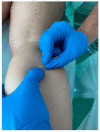The Effectiveness of a Single Dry Needling Session on Gait and Quality of Life in Multiple Sclerosis: A Double-Blind Randomized Sham-Controlled Pilot Trial
- PMID: 38200916
- PMCID: PMC10778988
- DOI: 10.3390/healthcare12010010
The Effectiveness of a Single Dry Needling Session on Gait and Quality of Life in Multiple Sclerosis: A Double-Blind Randomized Sham-Controlled Pilot Trial
Abstract
Introduction: Gait disorders are a major cause of disability and reduced health-related quality of life in people with multiple sclerosis (pwMS). Dry needling (DN) has demonstrated positive results to improve gait parameters in patients with stroke. The main aim of this study was to evaluate the effect of a single session of DN in the gait performance of pwMS.
Methods: A double-blind parallel randomized sham-controlled pilot trial was conducted. Study participants received a single session of active DN or sham DN in the gastrocnemius medialis muscle. Pre-treatment and immediately post-treatment measurements were taken, as well as at one and four weeks after the intervention. Outcomes related to gait performance (Timed 25-Foot Walk), self-perceived walking capacity (Multiple Sclerosis Walking Scale), risk of falls (Timed Up and Go test), disability level (Expanded Disability Status Score) and quality of life (Multiple Sclerosis Quality of Life-54 questionnaire and Analogic Quality of Life scale) were evaluated.
Results: 18 patients who had multiple sclerosis participated in the study. The group who received active DN showed within-group significant statistical differences immediately after treatment for gait performance (p = 0.008) and risk of falls (p = 0.008), as well as for self-perceived walking capacity at one week (p = 0.017) and four weeks (p = 0.011) and quality of life at four weeks (p = 0.014). Regarding the comparison between groups, only significant results were obtained in the physical domain of the quality of life at four weeks (p = 0.014).
Conclusions: DN seems to be a promising therapeutic tool for the treatment of gait disorders in pwMS. However, when results were compared with sham DN, no differences were found.
Keywords: dry needling; gait performance; multiple sclerosis; walking capacity.
Conflict of interest statement
The authors declare no conflict of interest.
Figures



Similar articles
-
Erratum.Mult Scler. 2016 Oct;22(12):NP9-NP11. doi: 10.1177/1352458515585718. Epub 2015 Jun 3. Mult Scler. 2016. PMID: 26041800
-
Effects of dry needling on gait and muscle tone in Parkinson's disease: a randomized clinical trial.Acupunct Med. 2022 Feb;40(1):3-12. doi: 10.1177/09645284211039232. Epub 2021 Sep 19. Acupunct Med. 2022. PMID: 34541889 Clinical Trial.
-
Effectiveness of Dry Needling versus Placebo on Gait Performance, Spasticity, Electromyographic Activity, Pain, Range-of-Movement and Quality of Life in Patients with Multiple Sclerosis: A Randomized Controlled Trial Protocol.Brain Sci. 2020 Dec 17;10(12):997. doi: 10.3390/brainsci10120997. Brain Sci. 2020. PMID: 33561042 Free PMC article.
-
Dry needling in multiple sclerosis: a scoping review.Acupunct Med. 2025 Apr;43(2):63-73. doi: 10.1177/09645284251327198. Epub 2025 Mar 21. Acupunct Med. 2025. PMID: 40116430
-
Changes in Gait Characteristics During and Immediately After the 6-Minute Walk Test in Persons With Multiple Sclerosis: A Systematic Review.Phys Ther. 2022 Jul 4;102(7):pzac036. doi: 10.1093/ptj/pzac036. Phys Ther. 2022. PMID: 35358308
References
-
- Grasso M.G., Pace L., Troisi E., Tonini A., Paolucci S. Prognostic factors in multiple sclerosis rehabilitation. Eur. J. Phys. Rehabil. Med. 2009;45:47–51. - PubMed
LinkOut - more resources
Full Text Sources

